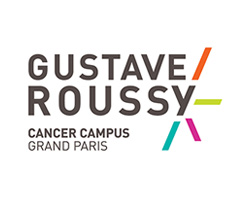Modeling In Vitro & In Vivo Radiotherapy Resistance in Diffuse Intrinsic Pontine Gliomas (DIPG)
Modélisation in vitro & in vivo de la résistance à la radiothérapie dans les gliomes infiltrants du tronc cérébral (DIPG)
Résumé
Diffuse intrinsic pontine gliomas (DIPG) are the most severe pediatric brain tumours. Though accepted as the main therapeutic, radiotherapy is only transiently efficient and not even in every patient. We previously identified a heterogeneous response to radiotherapy at diagnosis (Castel et al., 2015). The aim of the project was to define the mechanisms of radioresistance.First, we assessed in vitro response to ionizing radiations in a collection of DIPG cellular models derived from treatment-naïve biopsies and we uncovered TP53 mutation as the main driver of increased radioresistance. We validated this finding in 4 isogenic pairs of DIPG cells with TP53WT and TP53KD. Then, we demonstrated with an extended cohort of 73 DIPG patients that mutated TP53 patients had a poor response to radiotherapy. Using a kinome-wide synthetic lethality RNAi screen, we further identified target genes that can sensitize TP53MUT DIPG to ionizing radiations. CHK1 inhibition increases response to radiation specifically in TP53MUT cells and could be considered as a new therapeutic approach in this setting. Finally, we established in vitro radioresistant DIPG cells to study tumour relapse and we developed tools to model post-radiotherapy relapse through the study of clonal dynamics using single cell RGB marking.In all, this results go further in the understanding of the DIPG radioresistance. We demonstrated that a TP53 alteration is a theranostic marker to predict radioresistance and we opened new therapeutic opportunities in combination with radiotherapy for the treatment of this pediatric disease, which remains incurable.
Les gliomes infiltrants du tronc cérébral (DIPG) sont les tumeurs cérébrales pédiatriques les plus sévères. Le traitement standard, la radiothérapie, n’est efficace que transitoirement et la réponse est hétérogène. L’objectif du projet est de définir les mécanismes de radiorésistance.Tout d’abord, la réponse in vitro à l’irradiation de modèles cellulaires de DIPG dérivés de biopsies au diagnostic a été évaluée et nous avons identifié les mutations de TP53 comme principal facteur de radiorésistance. Ce résultat a été validé in vitro à l’aide de 4 lignées isogéniques TP53WT et TP53KD. Puis, nous avons montré au niveau clinique qu’une mutation de TP53 est un biomarqueur de non-réponse à la radiothérapie. A l’aide d’un crible d’ARN interférence, nous avons identifié différentes kinases essentielles à la survie des cellules de DIPG à l’irradiation. L’inhibition de CHK1 augmente la réponse à l’irradiation spécifiquement dans les cellules TP53MUT et pourrait être considérée comme une nouvelle approche thérapeutique en combinaison avec la radiothérapie. Enfin, des modèles cellulaires résistants à l’irradiation ont été mis en place pour étudier la rechute ainsi que des outils pour modéliser les processus moléculaires de résistance et d’échappement à la radiothérapie par suivi unicellulaire de la dynamique clonale des cellules tumorales par marquage RVB.Ces résultats vont plus loin dans la compréhension de la radioresistance des DIPG. Nous avons démontré qu’une altération de TP53 est un marqueur théranostic de prédiction de radioresistance et nous avons identifié de nouvelles opportunités thérapeutiques en combinaison avec la radiothérapie pour le traitement de cette maladie pédiatrique qui demeure incurable.
Origine : Version validée par le jury (STAR)

